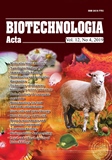ISSN 2410-7751 (Print)
ISSN 2410-776X (Online)

"Biotechnologia Acta" V. 12, No 4, 2019
Р. 42-49, Bibliography 23, EnglishUniversal Decimal Classification:
577.121.7/ 612; 618.3-57.04; 57.017.3
https://doi.org/10.15407/biotech12.04.042
DYNAMICS OF BRAIN ENZYMES ACTIVITY IN RAT EXPOSED TO HYPOXIA
Rashidova А. M., Babazadeh, S. N. Mammedkhanova V. V., Abiyeva E. Sh.
Academician Abdulla Garayev Institute of Physiology, Azerbaijan National Academy of Sciences, Baku, Azerbaijan
The aim of the work was to study the dynamics activity of lactate dehydrogenase (LDH; EC 1.1.1.27), aconitase (AH; EC 4.2.1.3), NAD-dependent malate dehydrogenase (MDH; EC 1.1.1.37), succinate dehydrogenase (SDH; EC 1.3.99.1) in homogenates and sub-fractions of brain structures of rat prenatally endured hypoxia at the organogenesis stage (in 11–15 days of development) and their role in the formation of compensatory - adaptive mechanisms in brain in postnatal ontogenesis. It was revealed that increasing of lactate dehydrogenase and malate dehydrogenase activity (P<0.001; P<0.01, correspondently) in the brain structures of the rats prevented metabolic disturbances in the regulation mechanisms of biosynthetic and bioenergetics processes in the brain. It has been shown that prenatal hypoxia upregulates aconitase activity in postnatal development and this process, probably, has a reversible character (P<0.01), the highest indices of succinate dehydrogenase activity were noticed in the hypothalamus and cerebellum of 30-day-old rat as compared to the other structures (P<0.001). Based on the data obtained, it can be concluded that hypoxia at the stage of organogenesis leads to a change in the energy supply process of the brain structures and, possibly, is irreversible. Analysis of changes in the enzymatic system in ontogenesis allows us to identify adaptation mechanisms and to assess the dynamics of changes in enzyme activity when the functional state changes, which make it possible to identify adaptive reserves of enzymes LDH, AH, MDH and SDH in brain exposed to hypoxia.
Key words: enzymes of energy metabolism.
© Palladin Institute of Biochemistry of National Academy of Sciences of Ukraine, 2019
References
1. Prabhakar N. R. Sensing hypoxia: physiology, genetics and epigenetics. J. Physiol. 2013, 591 (9), 2245–2257. https://doi.org/10.1113/jphysiol.2012.247759
2. Rashidova A. M. Effect of pre-/postnatal hypoxia on pyruvate kinase in rat brain. Int. J. Second. Metabol. (IJSM). 2018, 5 (3), 224–232, Turkey. https://doi.org/10.21448/ijsm.450963
3. Zhuravin I. A., Tumanova N. L., Vasilyev D. S. Changes in the mechanisms of brain adaption during postnatal ontogeny of rats exposed to prenatal hypoxia. Doklady biological sciences. 2009, 425 (1), 123–125. (In Russian). https://doi.org/10.1134/S001249660902001X
4. Golan H., Huleihel M. The effect of prenatal hypoxia on brain development: short- and long-term consequences demonstrated in rodent models. Dev. Sci. Jul. 2006, 9 (4), 338–349. https://doi.org/10.1111/j.1467-7687.2006.00498.x
5. Shvyreva E., Graf A., Maslova M., Maklakova A., Sokolova N. Acute hypoxic stress in the critical periods of embryogenesis: the influence on the offspring developmentin the early postnatal period. Europ. Neuropsycho pharmacol. Ed. Elsevier B. V. (Netherlands). 2017, 27 (9), 105. https://istina.msu.ru /publications/article/74505542
6. Pellerin L., Magistretti P. J. How to balance the brain energy budget while spending glucose differently. J. Physiology. 2003, 546 (2), 325. https://doi.org/10.1113/jphysiol.2002.035105
7. Belova N. G., Zhelev V. A., Agarkova L. A., Kolesnikova I. A., Gabitova N. A. Features of energy metabolism of cells in the mother-fetus-newborn system in pregnancy complicated by gestosis. Sibirskiy medicinskiy zhurnal. 2008, 4–1 (23), 7–10. (In Russian). https://cyberleninka.ru/article/v/osobennosti-energeticheskogo-obmena-kletok-v-sisteme-mat-plod-novorozhdennyy-pri-beremennosti-oslozhnennoy-gestozom
8. Pellegrino L. J., Pellegrino A. S., Cusman A. Z. A stereotaxic atlas of the rat brain. N. Y.: Plenum Press. 1979, 123 p.
9. Osadchaya L. M. Svobodnie aminokisloti nervnoy sistemi. Biohimiya mozga. S-Petersburg University. 1999, P. 29–58. (In Russian).
10. Chinopoulos C., Zhang S. F., Thomas B., Ten V., Starkov A .A. Isolation and functional assessment of mitochondria from small amounts of mouse brain tissues. Meth. Mol. Biol. 2011, V. 793, P. 311–324. https://doi.org/10.1007/978-1-61779-328-8_20
11. Bergmeyer H. U. Biochemica information. Meth. Enzym. Anal. 1975, V. II. https://books.google.az/books?id=jgIlBQAAQBAJ&pg=PA157&dq=Bergmeyer+H.U.+(1975).+Biochemica+information.&hl=ru&sa=X&ved= 0ahUKEwiNnt3b06PcAhUDlSwKHWbJDQgQ6AEILDAB
12. Guilbault G. G. In Handbook of Enzymatic Methods of Analysis. Marcel Dekker, N. Y. 1976, P. 509. (786 p.)
13. Proкhorova M. I. Metodi biokhimicheskih issledovanii. Izd-vo Leningradskogo universiteta. 1982, P. 210–212. (In Russian).
14. Kruger N. J. The Bradford method for protein quantitation. The protein Protocols Handbook, 3-rd ed. Ed. by J. M. Walker, Humana press Inc., Totowa N.J. 2009, P. 17–24. https://doi.org/10.1007/978-1-59745-198-7_4
15. Rashidova A. M., Hashimova U. F. Age-dependent activity of lactate dehydrogenase in brain structures during postnatal ontogenesis of rats exposed to hypoxia in the fetal period. J. Evol. Bioch. Physiol. 2019, 55 (3), 172–178. (In Russian). https://doi.org/10.1134/S0044452919030124
16. Zajchikova M. V., Alnaser A., Korolkova A. O., Epincev A. T. Regulyatornye i kineticheskie harakteristiki citoplazmaticheskoj akonitazy iz rastitelnyh i zhivotnyh tkanej. Vestnik VGU, seriya himiya, biologiya, farmaciya. 2010, V. 2, P. 81–84. (In Russian).
17. Sanjieva L. C. Acute hypoxia in female rats during periods of progestation and organogenesis. Vestnik Buryatskogo gosudarstvennogo universiteta. 2009, V. 4, P. 194–197. (In Russian). https://cyberleninka.ru/article/v/ostraya-gipoksiya-samok-krys-v-periody-progestatsii-i-organogeneza
18. Rashidova A. M., Gashimova U. F. Dependence of Activity of LDH and PK in Some Brain Structures of Rat from the Hypoxia Level Endured in the Stage of Organogenesis. Zh. Izvestiya NANA. 2017, 72 (1), 121–125 (In Russian). http://www.jbio.az/uploads/journal/e70929ecd0b2172f1485c15aaed81c57. pdf
19. Meerson F. Z. Adaptive medicine: mechanisms and protective effects of adaptation. Mosrva: Hypoxia Medical. 1993, 331 p. (In Russian).
20. Johnston M. V. Plasticity in the developing brain: implications for rehabilitation. Dev. Disabil. Rev. 2009, N 5, P. 94–101. https://doi.org/10.1002/ddrr.64
21. Anokhina E. B., Buravkova L. B. Mechanisms of regulation of transcription factor HIF under hypoxia. Zh. Biokhimiya. 2010, V. 75, P. 185–195. (In Russian). https://doi.org/10.1134/S0006297910020057
22. Semenza G. L. Hypoxia-inducible factors in physiology and medicine. Cell. 2012, 148 (3), 399–408. https://doi.org/10.1016/j.cell.2012.01.021
23. Speakman J. R., Selman C. The free-radical damage theory: Accumulating evidence against a simple link of oxidative stress to ageing and lifespan. BioEssays: news and reviews in molecular, cellular and developmental biology. 2011, 33 (4), 255–259. https://doi.org/10.1002/bies.201000132

